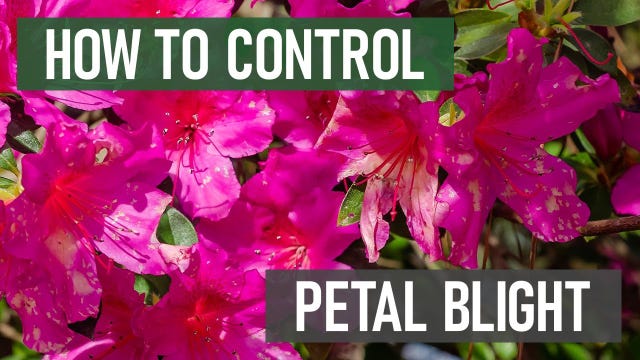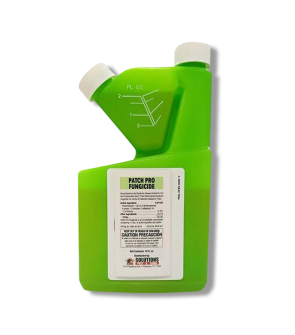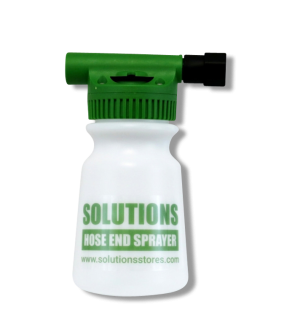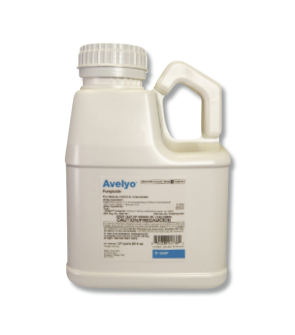Gain access to personalized product screening, the best pricing, rewards, and more!
Most Effective Products
Petal Blight (Flower Blight) Control: How to Get Rid of Petal Blight (Flower Blight)
This page is a general DIY guide for controlling petal blight. Using the products and methods suggested, you will get control of petal blight infestations. Follow this DIY article and use the recommended products, and we guarantee 100% control of petal blight.
Each year, the buds and flowers of ornamentals turn brown and fall off the plant. If this happens, the most likely culprit is a fungus called petal blight, also known as ovulinia flower blight, flower blight, azalea flower blight, and azalea flower spot.
The infection from this fungus results in small, brown spots that quickly enlarge until the entire foliage becomes brown and falls off the plant. Once the diseased flower has fallen, it will spread into the soil and surrounding leaf litter until the following spring, thus continuing its lifecycle.
Once established, it's very hard and sometimes impossible to control. Any flowers showing signs of this disease should be treated as soon as possible with the following professional tips and products in our DIY guide.
Identification
Before treating it, you must be sure you are dealing with petal blight and not some other disease or issue. Misidentification may lead to wrong treatment methods, wasting your time and money. Some symptoms are below to help you identify petal blight.

- In its early stages, petal blight creates small, irregular-shaped white or brown spots on the plant petals before extending to the entire flower. This often causes the flower to become slimy and fall apart more quickly. This sliminess is a characteristic of petal blight that is not present in other diseases.
- Once infected, the flower petals will become leathery brown, and the flowers will drop prematurely.
- Depending on the species, some petal blights may or may not create webbing on parts of the plant.
- Eventually, the flower dries and forms black structures called sclerotia. These are irregularly shaped and can be up to half an inch long. After the flowers dry, the petals and sclerotia fall to the ground.
Refer to the image above and our description to help you identify petal blight. If you are having trouble, contact us; we'll help you correctly identify your issue.
Inspection
After you have confirmed that you are dealing with petal blight, you can move forward with an inspection. During this phase, you will locate where the petal blight is thriving and how severe the issue is.

Where to Inspect
Petal blight affects only the flower petals on a variety of plants throughout various times of the year.
It's common on camellias, azaleas, rhododendrons, and dogwood trees.
What to Look For
Petal blight becomes active when temperatures have been mild as the flowers bloom, usually between 50 and 70 degrees Fahrenheit, and the flowers are frequently wet due to rain or excessive irrigation.
As flowers start to grow, look out for discolored spots. On white flowers, the spots appear brown. On other flowers, the spots appear white. As the disease progresses, these spots grow larger and eventually overtake the entire flower.
When the plant is heavily infested, the flower will become brown and leathery and fall from the plant.
Treatment
Before treatment, be sure to wear the proper personal protective equipment (PPE) before mixing and applying fungicides.
Controlling petal blight on ornamentals involves a combination of good cultural practices and approved fungicides. Fungicides containing chlorothalonil, thiophanate methyl, triforce, or propiconazole can help control petal blight outbreaks.
Once a plant is infested with this disease, it is almost impossible to control. The best thing to do is to make applications as early as possible.
Step 1: Prune Infected Plant Parts
 First, remove the infected parts of the flower leaves, buds, and petals with pruners. Pick up any plant parts that have fallen to the ground as well.
First, remove the infected parts of the flower leaves, buds, and petals with pruners. Pick up any plant parts that have fallen to the ground as well.
Diseased plant parts should be properly disposed of and not intended for use as compost or other general lawn care practices.
Before pruning the next plant part, disinfect the pruners and other equipment used for infested foliage to prevent the bacteria from spreading.
You may also need to replace the top inch of soil or mulch to ensure you have removed all spores from your garden.
Step 2: Adjust Watering

In addition to pruning discolored ornamental leaves and flowers, you will need to adjust how you water your flowers.
Avoid watering your flowers overhead; instead, water them at the base level, close to the soil. When water sits on top of the petals, this creates an ideal environment for the fungus to develop.
It's best to avoid watering in the evening and at night, as there is not enough time and heat for the moisture to absorb. If you irrigate your plants later in the day, the water is likely to evaporate before your plant can absorb it and may result in heat stress.
Instead, water during the early morning with an inch of irrigation once per week to prevent overwatering and give the plant enough time to absorb moisture.
Step 3: Apply Fungicide
Once you have removed infected flowers and adjusted your watering, you will need to apply a fungicide like Patch Pro Fungicide.
Fungicides like Patch Pro Fungicide will do the job well. Patch Pro Fungicide is a propiconazole concentrate fungicide that will control many lawn and ornamental diseases, including petal blight (known as flower blight on the label).
The density and height of your target plants will determine your necessary spray volume.
Spray volumes typically range from 80 to 100 gallons of water per acre, depending on the equipment you choose.
To treat active petal blight symptoms, mix Patch Pro at the labeled rate of 5 to 8 fluid ounces of product with 100 gallons of water.
For smaller areas, mix one-quarter of a fluid ounce of product with one gallon of water. This will control petal blight as well as other diseases or fungi that may be present.
For large sites like nurseries, applications can be made with a hose end sprayer. For smaller sites like residential gardens, use a handheld pump sprayer.
Simply apply your solution as a full-coverage spray to the point of drip, spraying all flowers and foliage, including the leaves.
Apply as needed, beginning when conditions are favorable for disease development.
Make reapplications no more often than every 21 days. For the best control, begin Patch Pro applications before disease development has started.
In order to control petal blight, it would be best to begin before the first sign of the disease or during its early stages.
Prevention
After eliminating the petal blight outbreak, you want to ensure it doesn't return. Prevention is the best cure when it comes to petal blight. Here are some preventative tasks we suggest:
- Once petal blight is no longer visible, maintain regular ornamental plant care to improve your plant's health. Remove discolored flower petals and leaves from the plant. Clean the pruners before and after pruning to prevent the spreading of diseased materials. This also goes with other tools you are using for ornamental purposes.
- Space the ornamentals apart to give them enough room to grow. The space between each plant should be enough for airflow. Additionally, this will help the plants dry more quickly after irrigation and rain.
- Avoid overhead watering on the ornamental flowers and leaves. Stagnant moisture on these plants, especially in the fall, helps the spores germinate more quickly. Prevent this by watering the plant's base early in the morning. Water with no more than 1 inch of irrigation once per week.
- Lastly, as an added measure, apply Patch Pro Fungicide when the weather consistently has mild temperatures between 50 and 70 degrees Fahrenheit. When used preventatively, Patch Pro will protect treated plants for up to 30 days, so make applications once a month to ensure protection throughout the year.
Key Takeaways
What is Petal Blight?
- Petal blight is a common disease that attacks ornamental flowers. It typically infests these plants during the flowering stages in mild to warm, wet weather.
How to Get Rid of Petal Blight
- To get rid of petal blight, you must prune away the plant's diseased parts and apply Patch Pro Fungicide as soon as possible.
Preventing Petal Blight Reemergence
- Prevent petal blight by applying Patch Pro Fungicide, adjusting watering to the base of plants, regular pruning, and spacing the plants apart so enough air and moisture can come through.












